How Gregory Gourdet Is Creating a Home for Haitian Cuisine in Portland, Oregon
- Oops!Something went wrong.Please try again later.
At Kann, Gourdet offers a deeply personal interpretation of Haitian cuisine.

Jose Mandojana
Gregory Gourdet"The griyo took five years to dial in," chef Gregory Gourdet says to me in a small office above his restaurant, Kann. It’s early afternoon, and the building on Ash Street in Portland, Oregon, is buzzing with team members getting ready for that evening’s dinner service: line cooks eating a family meal of pasta and salad, managers printing menus for review, servers polishing glassware and setting up the dining room. Despite the activity going on around us, Gourdet is calm, almost quiet, as he tells me about the most popular dish on Kann’s menu.
Griyo is the kind of dish that takes multiple tries to do correctly, Gourdet informs me. Deceptively simple, it consists of luscious, crispy-edged pork pieces made by roasting the pork with aromatics and then frying it. Cook the pork too long, and you’re left with mushy pieces that won’t hold up to frying; not long enough, and you’ll get chewy pork that isn’t properly rendered. Considered by some to be the national dish of Haiti, griyo (also spelled griot) is typically served with rice and pikliz, Haiti’s all-purpose pickled cabbage condiment, each component bringing its own texture to the dish. At Kann, Gourdet’s griyo is an explosion of color: tender, dark mahogany–colored lacquered pork pieces served alongside bright green avocado slices, golden fried plantains, and a fluorescent-pink pikliz. It’s a visually playful take that’s still recognizable to those who know the classic version — and most importantly, it’s delicious. “It was really important to me to get that right,” he says.
For Gourdet, learning to get it right is a theme of the lifelong journey that culminated in the 2022 opening of Kann, his much-acclaimed wood-fire-focused restaurant and culinary love letter to Haiti. In Kann’s open kitchen, Gourdet and his team turn out warm plantain brioche buns; greens cooked down with peanuts and coconut cream; north Pacific salmon served with stewed peppers. The menu is the accumulation of a life and career of experimentation eventually giving way to Gourdet’s own unique expression of what matters most to him that he can share with others.
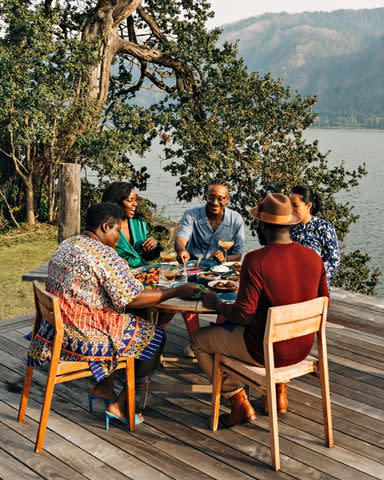
José Mandojana
Gourdet (middle) and friends (clockwise from right) Varanya Geyoonsawat, George Faux, Elsy Dinvil, and Fatou Ouattara sit down to a summer feastGourdet grew up on the East Coast, raised in Queens, New York, by his Haitian parents and by his grandmother, who lived in Newark, New Jersey. After church on Sundays, he, his parents, and his sister would go to his grandmother’s house for Haitian dishes like chicken in Creole sauce, diri ak sos pwa (rice and stewed red kidney beans), and fried plantains, either green and starchy or sticky-sweet, on the side. Gourdet first planned to be a doctor, attending NYU for a while for pre-med classes, before ultimately getting a degree in French from the University of Montana. While working at a sandwich shop, he discovered that he loved feeding people and opted for culinary school, attending the Culinary Institute of America. Afterward, he worked at Jean-Georges in New York City, making his way up from line cook to chef de cuisine. He moved to Portland in 2008, eventually garnering acclaim at Departure, where he cooked fresh takes on pan-Asian cuisine. As the years went by, the Haitian dishes of his childhood became a well of inspiration that he yearned to draw from.
Related: The 'Top Chef' Guide to Portland
The name Kann comes from Gourdet’s memories of visiting Haiti as a child and of street vendors yelling out the Haitian Creole word for sugarcane. The idea for the restaurant solidified during Gourdet’s season of Top Chef: All Stars L.A., which filmed in 2019 and aired in 2020, after which Gourdet continued exploring Haitian cuisine through pop-ups in Portland. When I first spoke to him about Kann in late May 2020, it was clear that the concept was fully formed in his mind. He was set on serving Haitian food on his own terms sometime in 2021, he told me then. “I’m just so excited to have more time to plan.” What we didn’t know then was that protests, heightened racial tensions, and waves of pandemic-related lockdowns would disrupt those plans for the next two years.
Adding to the tumult, in 2021 Gourdet was also called to task by former coworkers for not doing enough to protect former employees from workplace discrimination and harassment while working as executive chef and culinary director at Departure in Portland and Denver, respectively. The experience, he says now, helped him see the ways in which he had to grow as a leader. At Kann, he decided, things would work differently. The old hospitality adage of “leave your feelings at the door” had to go, and employees had to know their voices would be heard. Collaboration became a guiding principle for Gourdet, and he sees it as a vehicle for every employee who works at Kann. Kann also uses a tipping model that distributes tips among the front and back of house, and all servers and cooks are paid the same hourly wage.

José Mandojana
Gourdet and his friend chef Elsy Dinvil share a laugh while preparing Akra“His food is shaped by his life experience and makes sense when you look at his story,” says JJ Goode, coauthor of Gourdet’s cookbook, Everyone’s Table. “He’s at this lucky moment in his career where he can use this cuisine to tell his story,” Goode says. “His cuisine is his life.”
That’s true outside of the restaurant, too. Gourdet spends many of his days off cooking for his chosen family, a circle of friends who are mostly in the hospitality industry as well. On a recent afternoon at a friend’s house outside the city, Gourdet prepared a dinner for writer and director George Faux; Fatou Ouattara and Elsy Dinvil, two chefs from Côte d’Ivoire and Haiti, respectively, who also call Portland home; and Varanya Geyoonsawat, Kann’s chef de cuisine. “It’s nice to stop and take care of them for a bit,” Gourdet says. He prepared steelhead trout rubbed with epis, roasted sweet plantains with a jolt of jerk seasoning, and a salad of pickled peaches, roasted tomatoes, and fresh berries. The menu was a personal rendition of Caribbean cuisine, presented through the lens of someone who has found home on the West Coast and was exploring himself and his cooking there.
In Portland, that can be challenging, says Dinvil. Her company, Creole Me Up, specializes in allergen-free Haitian condiments, and she has lived in Portland since 1999. To be a Haitian chef in the city requires “constant teaching,” she says. “But compared to when I started, people have come far.” She sees Kann as a stepping stone for more Haitian-owned and Caribbean-focused businesses in the area. At Kann, “Gregory not only brought Haitian cuisine but also Haiti as a country so beautifully,” she says.

José Mandojana
Gourdet with his dinner party guestsBecause a cuisine cannot be extracted from the culture of the people who produced it and the history that informs it, Gourdet brought in Bertrhude Albert, an expert on Haitian history, to talk to his team about the background of certain dishes and ingredients in Haitian cuisine. “She flew out and did two days with us: a full day on the history of Haiti, from the Indigenous folks, the Arawak, to Christopher Columbus landing, to Spanish rule, to the French and colonization, to the enslavement of the West Africans brought over,” Gourdet says. Covering the Haitian Revolution and how Haiti became the first Black free republic in 1804 led to conversations about how Haiti has inspired liberation movements around the world. “It’s a complex history that is not often talked about,” Gourdet says, and knowing it helps you understand the influences found within Haitian cuisine. Kann’s akra, fritters made with taro root, for example, are directly tied to West African accara, fritters made with black-eyed peas. Servers give diners a brief history of dishes and encourage them to ask questions. For many chefs, creating a menu or a dish is about evoking a feeling or exploring an ingredient, but for Gourdet, his menu is about sharing with the public the nuances in Haitian cuisine. “It would defeat the purpose of having a Haitian restaurant if you’re not walking away and going, ‘I know what Haitian food is now.’”

José Mandojana
The Columbia River outside of PortlandThat’s not to say that there aren’t some liberties taken. Gourdet uses locally grown habaneros when he can’t find Scotch bonnets on the West Coast, and the crispy plantains are fried twice, similar to tostones or french fries, because he found that method produced the most satisfying texture. It’s in this space, between Haiti as inspiration and the experimentation of a chef using a scientific approach to creating his own interpretations, that Gourdet and Kann exist. Some have asked if Gourdet’s cooking can even be called Haitian food, he says. It’s a moot point. “Is it good or not? That’s the question.”
The answer is pretty obvious. Gourdet’s cooking envelops you with the smell of woodsmoke, a delicious level of heat, and the interplay of unctuous ingredients and textures. The flavors of the Caribbean are present and distinctly Haitian in orientation, bolstered by the bounty of the West Coast.
When I ask Gourdet if there’s a sense of pressure, he quickly says no. “A lot of things have fallen into place, and we do what we need to do.” His journey has led to exactly where he wants to be — and he’s still learning. “When you find your calling, you start looking back and see all the things that led you to this place.”
Gregory Gourdet recipes
Tomato Salad with Coconut Dressing

Jose Mandojana
There’s an interplay of savory and sweet in this dish, with the combination of tomatoes (concentrated from roasting), vinegar-brined peaches, and fresh summer berries. While Gourdet features peaches in this recipe, other stone fruit, such as nectarines, makes a good stand-in. Choose ripe but firm fruit to prevent the flesh from becoming overly soft while it pickles. Topped with a tangy coconut dressing, fresh herbs, and edible flowers, this salad is a summer stunner.
Epis-Rubbed Steelhead Trout
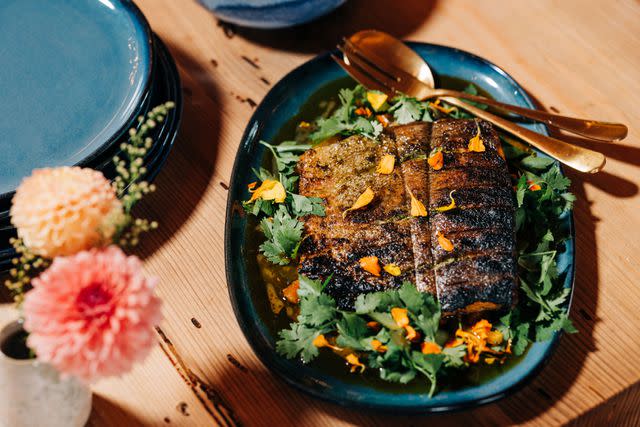
José Mandojana
Served with stewed peppers, this tender fish is infused with herb and oniony notes and a little vinegar-and-lime tang from Gourdet’s homemade epis, a fundamental Haitian seasoning paste. Scoring the trout helps evenly flavor the fish and makes cut- ting through the crispy skin easier.
Red Chile Jerk–Spiced Roasted Sweet Plantains
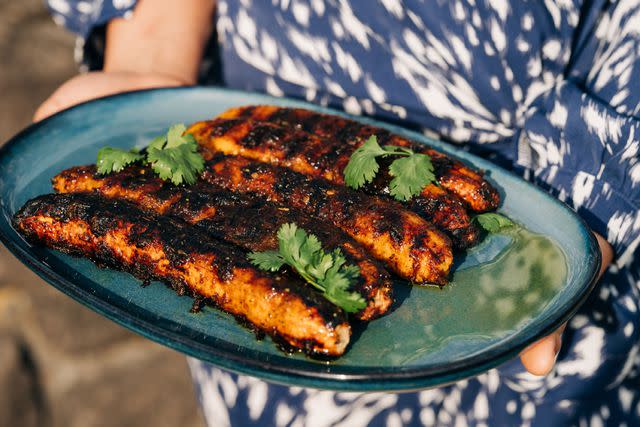
José Mandojana
Basted and glazed with his vibrant and fiery jerk sauce, Gourdet’s grill-roasted plantains are a caramelized combination of sweetness, heat, and spice. To cook the plantains evenly without burning them, begin by charring them over high direct heat on the grill, then coat them with the jerk sauce and finish cooking them at a lower temperature over indirect heat.
Pikliz (Haitian Spicy Pickled Cabbage)
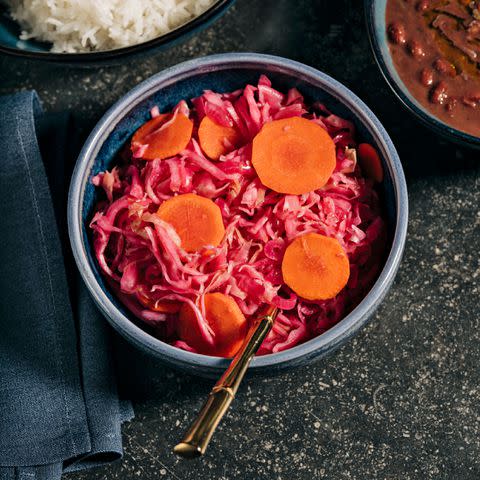
José Mandojana
This spicy condiment is almost a given at the Haitian table. Gourdet makes this ver- sion with thinly sliced red cabbage, white onion, and carrots for a magenta-colored slaw that retains its crispness even after a daylong soak with vinegar, lime, and hot chiles. The taste of the cabbage and carrots intensifies with tangy, acidic flavor as the mixture sits, so don’t skimp on the marinating time.
Akra (Crispy Taro Root Fritters) with Caviar and Remoulade
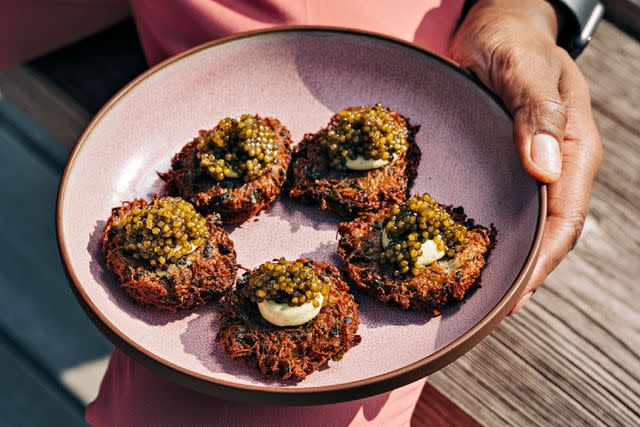
José Mandojana
Akra are crunchy root-vegetable-based Haitian fritters. Gourdet makes his by finely grating fresh taro root and tossing the shreds with scallions, garlic, chile, and herbs. Egg binds the mixture, which is fried in batches to achieve a crisp, golden crust that reveals a creamy, garlicky interior. Topping the akra with his zesty remoulade would be enough, but Gourdet takes this popular bite to a luxurious level with a finishing dollop of briny osetra caviar.
Diri ak Sos Pwa (Haitian Rice with Bean Sauce)
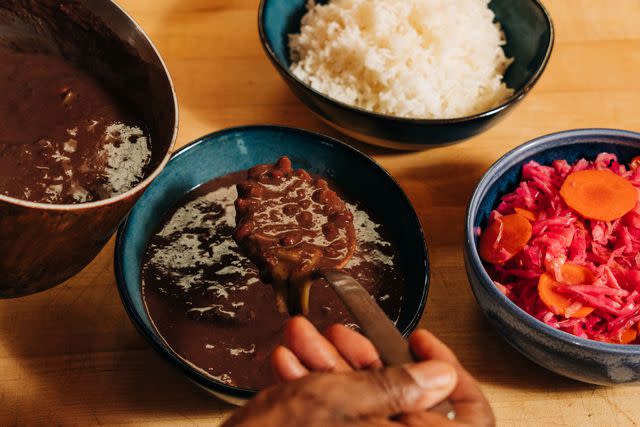
José Mandojana
For this traditional Haitian dish, rice (diri) is served with a flavorful bean sauce (sos pwa). In his version, Gourdet simmers kidney beans with onion, garlic, thyme, and a dash of clove for a hint of pungency and then blends them until smooth and saucy.
Pineapple and Tamarind Cooler

José Mandojana
This tangy and sweet nonalcoholic drink delivers a little kick of heat thanks to the mix of habanero powder and salt that rims each glass. Gourdet uses tamarind pulp to make a fruity, tart syrup that helps balance the tropical sweetness of the pureed pineapple. The drink has a slightly thick consistency, but served over plenty of crushed ice, it’s perfectly refreshing.
For more Food & Wine news, make sure to sign up for our newsletter!
Read the original article on Food & Wine.

